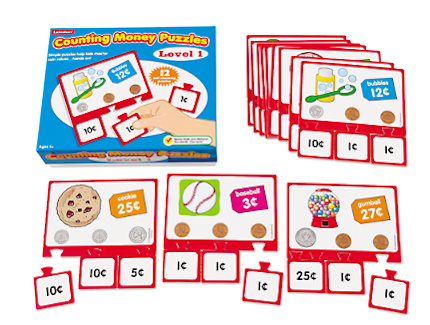 |
Counting Money Puzzles Level1 - Self-correcting money puzzles |
Work on coin identification, coin value, and adding coins with these 12 self-correcting money puzzles. Each puzzle consists of a larger piece with a picture of an item and its price, and three small pieces to match the value to the coins. The puzzle shows you the three coins to equal the price and the individual must match the amount to each of the coins, such as 1 cent equals a penny.
Puzzles are self-correcting, meaning an incorrect piece will not fit snugly in the wrong place. I have used Counting Money level one for years, and only recently found out there is also a level two and three, which advance in difficulty. You can purchase the levels separately or as a set from Lakeshore Learning. I have blogged about level 2 here, but I don't own level 3.
To see a list of games with money that I have blogged about, click here.
Try this:
- Place actual coins on top of the coin pictures.
- Make sure that some of the actual coins are upside-down and flat on the tabletop. Ask the individual to pick up the coins one at a time and turn them in-hand to the correct side and orientation to match the coin on the puzzle before placing it on top of the picture.
- Place the three coins needed for each puzzle in the individual's palm and ask him to bring them to the fingertips, one at a time, and orient them for placement without dropping any.
- Ask the individual to sort all of the coins into a money tray before starting. Then after assembling each puzzle, ask him to pick up the three coins needed, one at a time, and squirrel them in the palm without dropping any.
- Place the puzzle pieces flat on the table and in different orientations. After picking up a piece, ask the individual to shift it in his fingertips to orient it for placement.
- Choose one picture, such as the cookie (25¢). Attach the puzzle pieces and then use other puzzle pieces to make piles of other ways to count out 25¢. For instance 5 - 5¢, 5 - 1¢ plus 2 - 10¢, etc.
- Skip the pictures, just use the ¢ cards. Place one coin under each card that matches the ¢. Ask the individual to verbally identify the coin and how much it is worth. For instance, under the 10¢ card, say dime and 10¢.
- Work on money skills, visual discrimination, manual dexterity, fine motor precision, spatial relations, in-hand manipulation, visual closure, executive functioning skills, process skills, play and leisure exploration and participation

No comments:
Post a Comment
Thank you for taking the time to comment.